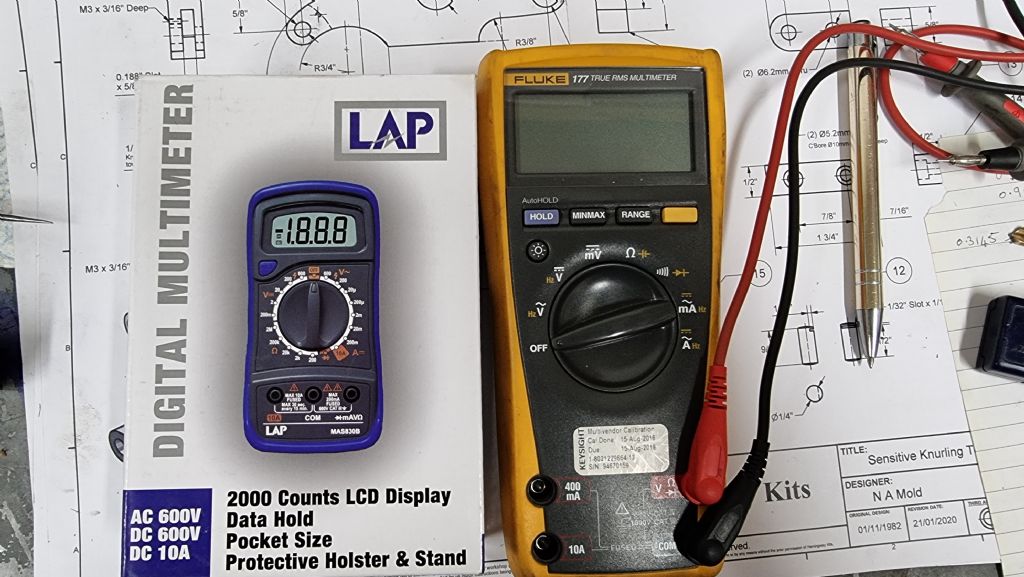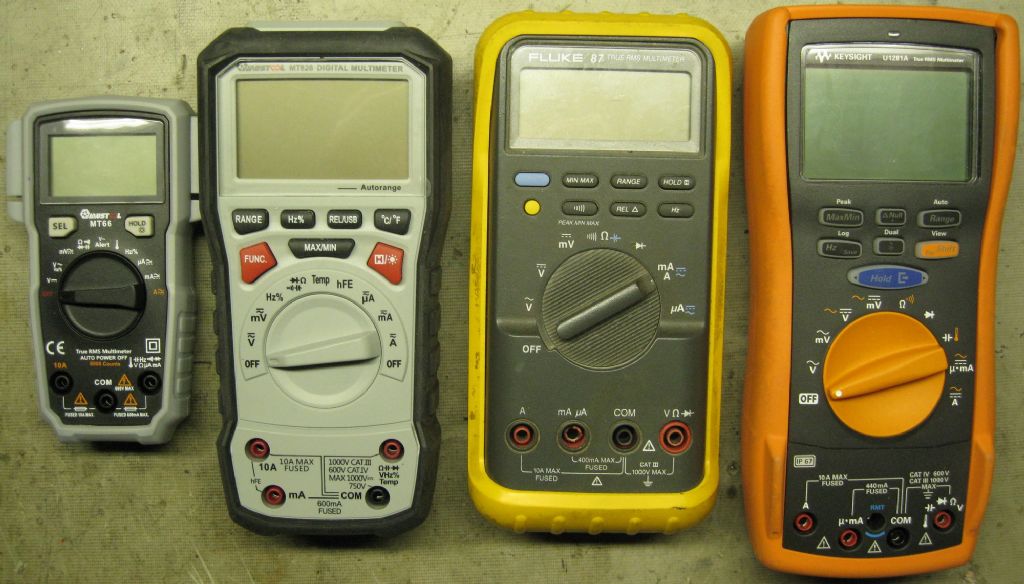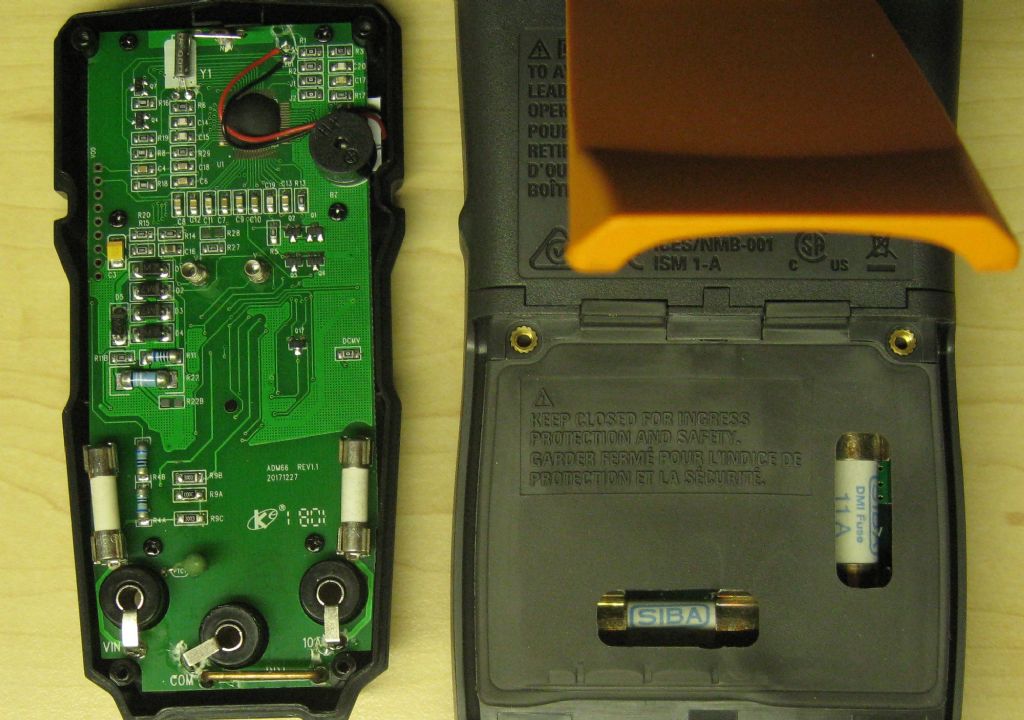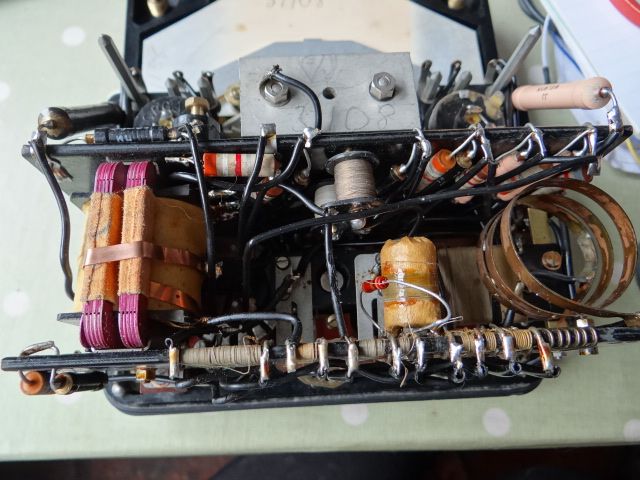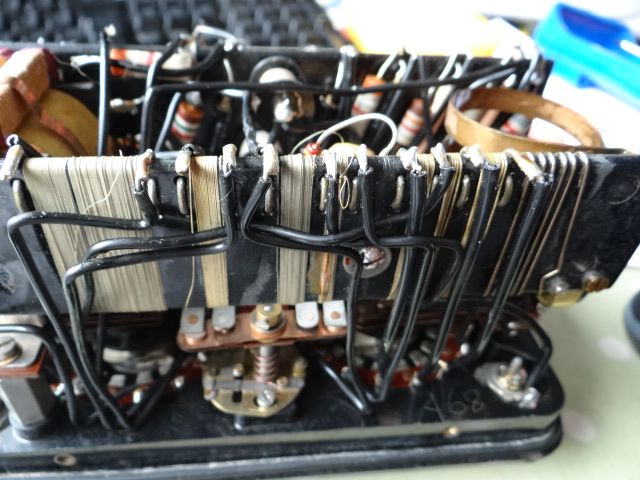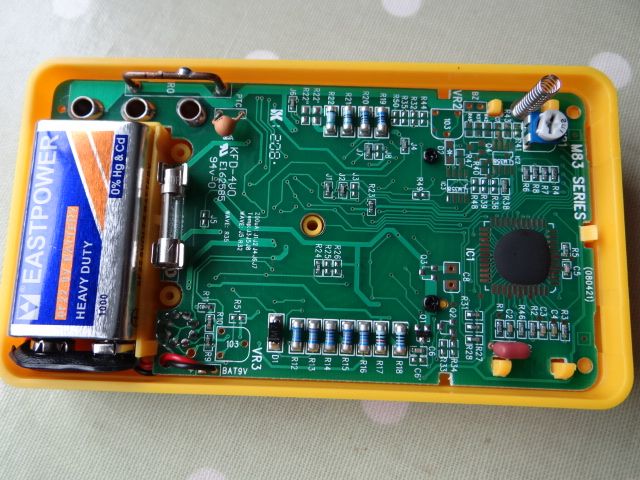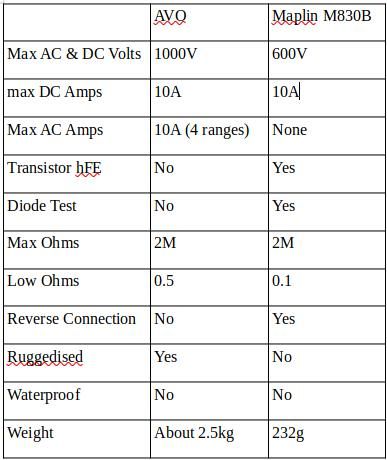Multimeter recommendations
Multimeter recommendations
Home › Forums › Electronics in the Workshop › Multimeter recommendations
- This topic has 103 replies, 41 voices, and was last updated 26 September 2021 at 22:20 by
 Michael Gilligan.
Michael Gilligan.
-
AuthorPosts
-
7 September 2021 at 20:37 #561843
 Robert Atkinson 2Participant@robertatkinson2
Robert Atkinson 2Participant@robertatkinson2Unfortunatly a cheap multimeter may not be safe. Anything new costing under £10 is unlikely to be properly designed and constructed to the standards required for safe use on mains.
7 September 2021 at 21:37 #561849Maurice Taylor
Participant@mauricetaylor82093Posted by Robert Atkinson 2 on 07/09/2021 20:37:03:Unfortunatly a cheap multimeter may not be safe. Anything new costing under £10 is unlikely to be properly designed and constructed to the standards required for safe use on mains.
Hi,you’ve just recommend one “72-13440” which is only £7.84 sold by CPC.
Maurice
7 September 2021 at 21:47 #561850 Robert Atkinson 2Participant@robertatkinson2Posted by Maurice Taylor on 07/09/2021 21:37:56:Posted by Robert Atkinson 2 on 07/09/2021 20:37:03:
Robert Atkinson 2Participant@robertatkinson2Posted by Maurice Taylor on 07/09/2021 21:37:56:Posted by Robert Atkinson 2 on 07/09/2021 20:37:03:Unfortunatly a cheap multimeter may not be safe. Anything new costing under £10 is unlikely to be properly designed and constructed to the standards required for safe use on mains.
Hi,you’ve just recommend one “72-13440” which is only £7.84 sold by CPC.
Maurice
Interesting, and a bargain, not a normal price. Farnell sell it for £21.55 and they own CPC!
https://uk.farnell.com/tenma/72-13440/dmm-handheld-manual-2000-count/dp/2854404
I did say "unlikely to be" there are always exceptions
 8 September 2021 at 00:24 #561859
8 September 2021 at 00:24 #561859Paul Kemp
Participant@paulkemp46892Posted by Robert Atkinson 2 on 07/09/2021 17:36:49:Why don't people READ posts?
OP wants a reliable meter, an ebay cheapie is not that. An analog is not really a practical general purpose meter these days..My personal preference would be a used Fluke but this does not normally provide the transistor tester requested and isn't new. The transistor testor is a bit of a gimmik on the very cheap meters.
If you wand a good new meter under £20 took at a Tenma 72-13440,
For the transistor tester get a £3.50 ebay meter but don't use it on mains.
Some will complain that my suggestion is manual ranging, but that is much better than a slow autoranging one.
Robert G8RPI.
I like your confidence that a Fluke won't explode. I was on board ship in 2015 working on a bit of kit close to the 415v switchboard. The electrician was doing something on the switchboard on a low step up platform stood on the switchboard matting. I am unsure exactly what he was up too but he was checking something on the main bus mounted in the top of the switchboard using a brand new fluke just out of the box that day, supplied with a calibration cert – purchased from the US Fluke dealer in the locality. Long story short there was a massive flash and a bang and leccie was on the floor still holding the two undamaged leads, from each was dangling part of the meter, the remainder was spread all around the space! I don't know what he was up too but he was a certificated ETO of many years experience, he didn't get a an electric shock but he certainly got a surprise shock, as did I! He repeated the task he was up to after he changed his trousers with the old meter that was out of cert and it went fine (identical model – I had purchased the new one as we couldn't get the old one calibrated quickly enough). There wasn't enough left of the meter to be able to tell with certainty what range or function it was set too! I guess there is always an exception to the rule but certainly they can be blown up!
Paul.
8 September 2021 at 01:01 #561860 SteviegtrParticipant@steviegtr
SteviegtrParticipant@steviegtrHere are a couple which I have. These are 2 of around 10 different types I have. Ex Electrical contractor so had to have many different ones inc for full Inspection & testing to IEE regs. The ones below are a expensive Fluke, a superb meter. Downside is they are very expensive. The other is from memory a £8.99 item from Screwfix. A great little meter. A no no is the ones that Lidl occasionaly sell. They are rubbish. Maybe Aldi too. None of mine have transistor or capacitor testers though. Although if you know how to use a multimeter these tests are easy to do just using the Resistance settings.
Steve.
8 September 2021 at 02:35 #561862brian jones 11
Participant@brianjones11Get the new hall effect c clamp type meter. it can measure DC Amps just by clipping on a wire and NOT breaking the cct. Its a godsend and quite accurate
UNI-T UT210E about £65 worth every penny
Dont knock the old analog Avo type. you see things on the needle sweep you d never pick up on a digit display.
cheapo ok for LV
If doing serious mains work get proper kit for the job.
IMHO get cheapo digit one for auto work cos you are bound to blow one up with current range wrong.
8 September 2021 at 04:01 #561865Anonymous
Posted by Paul Kemp on 08/09/2021 00:24:12:………Long story short there was a massive flash and a bang and leccie was on the floor still holding the two undamaged leads………..
Almost certainly had it set on DC current, been there done that. Many years ago I went to measure a 730V DC bus with my mid-range Maplin multimeter. Unfortunately I had it set on the 10A range. Despite the range being fuse protected the multimeter literally exploded. The range selector knob was found on the other side of the room.
Andrew
Edited By Andrew Johnston on 08/09/2021 04:09:12
8 September 2021 at 07:56 #561867Joseph Noci 1
Participant@josephnoci1All the meters I have used have separate inputs for current, so must be a real lapse in focus to measure volts with the meter set so..
I think the 'cheap' meters are still pretty good value for money, if the intended use is around the house, shop and car.
WRT safety, even the cheapies don't appear too bad – certainly the high current ranges – 10amps plus etc, may be a bit suspect – pcb tracks are in some cases a little narrow for prolonged use at higher currents. Voltage separation of tracks in the cheapies I have seems quite adequate – nothing less than 6mm gaps that I found.
If the use is more professional, then accuracy may be more important, and very specific needs would then dictate a better instrument.
The two left meters are MusTool left was $9.00, 2nd from left was $18.00
Both work very well, I use them in the workshop, on 4×4 trips, etc. third from left is the venerable FLuke 87, this one now 26 years old and working as new. Next was my gift to me to replace the Fluke 87, a Keysight 5-1/2 digit meter – Very good at measuring, can record to a PC, etc – was $604.00 (!).
However, this was a bad buy -the Keysight display is crappy, not clear, hard to read in day without the backlight on(!!), the knob has a very uncomfortable rotational backlash which results in one not being sure if the required selection in made or not.. I use it for the more exacting tasks – measuring and computing ampere-hours for very low power wildlife tracking collars and so on. The Fluke and the Keysight unit are in the electronics lab all the time, and nine out of ten times I'll go for the Fluke. I could not physically view the Keysight unit when I purchased, went on reviews and made a mistake in purchasing it. I should have gone for the later Flukes (s). So price is not all – The only downside I found to the two cheapies shown here is the display update time is long – maybe 1 to 2 sec, and autorange time is irritatingly long – up to 4 seconds…The Fluke is less than 1 sec, the Keysight not noticeable.
Measuring +12V on each unit showed ( left to right) 11.88v , 11.9v, 12.01v, 12,002v
Current measurements showed:
0.5amps: left to right – 0.25A , 0.48A, 0.511A, 0.505, 0.5007A
1Amps : 0.98A , 0.97A, 0.99A, 1.0008A
10Amps : 9.77A, 9.89A, 9.98A, 9.9997A
So I think The Cheapies are just fine, except for the sub 0.5A anomaly of the left meter..
Fuse setup of the cheapest versus the costly meter..
Given the lesson, and what Fluke has done for me over the last 1/3 of a lifetime, I would try find a FLuke…
Joe
Edited By Joseph Noci 1 on 08/09/2021 07:58:57
Edited By Joseph Noci 1 on 08/09/2021 08:00:19
8 September 2021 at 09:33 #561873Anonymous
Posted by Joseph Noci 1 on 08/09/2021 07:56:08:……..must be a real lapse in focus to measure volts with the meter set so……..
We can't all be perfect.

Andrew
8 September 2021 at 10:17 #561883 Jon LawesParticipant@jonlawes51698
Jon LawesParticipant@jonlawes51698The cheap meters do have their place for me, for example when I drove classic cars a small cheap meter fits nicely in the glovebox to help when you are roadside trying to diagnose the fault of the day. I kept the Fluke for everything else. However the place even the best made cheap meter seemed to let me down was the quality of the leads and probes, which seemed very flimsy and fragile. That being said I'm sure things have improved.
8 September 2021 at 10:18 #561884Nick Clarke 3
Participant@nickclarke3Moving away from the OPs question, while I have a number of meters (quality, AVO and yellow cheapies) I recently bought an inexpensive Chinese made digital meter with bluetooth that talks to my phone which then speaks the reading aloud.
So when you are struggling to take the reading and unfortunately have forgotten your extra hand and extra pair of eyes to hold and look at the reading you can just put it somewhere nearby, out of sight if necessary and hear what it says.
Originally bought for blind students to hear what was being measured I have found the facility useful in awkward positions (and FAR less dangerous than an assistant to take the readings for you!)
8 September 2021 at 10:54 #561895SillyOldDuffer
Moderator@sillyolddufferPosted by brian jones 11 on 08/09/2021 02:35:31:Dont knock the old analog Avo type. you see things on the needle sweep you d never pick up on a digit display.
…
Good point, which is why I own digital AND analogue meters. I recommend buying one of each!
Digital meters are hard to misread but need time to settle, so best for measuring steady volts and amps accurately. For a bit more money the meter can do frequency, capacitance, and inductance, plus reasonably useful transistor testing.
Analogue meters are easy to misread, but are good for many common situations where a quick check is good enough: continuity ; does a power rail have roughly the right volts on it, etc. They're especially useful for detecting changes like capacitors discharging, batteries and power rails fading under load or motor boating. My analogue meters also detect RF oscillation by going full scale on all ranges by detecting on the movements protective diodes.
I own a genuine AVO, same age as me but the meter is still in good working order. Don't use it much because it's heavy and inconveniently beefy. Mainly valued for it's 10A AC range. It's unusual 27V battery is a mild pain to source.
The analogue that gets most use is an inexpensive rather than cheap 20000 ohms per volt Japanese plastic hobby meter. Fully portable, and – unlike the AVO – can be propped up to ease reading the scale. 30 years old, takes ordinary batteries and accurate better than 3% on all ranges last time I checked.
Otherwise, I have a couple of Maplin digitals. The second was bought because I lost a lead and it was cheaper to buy a new meter than a set of new leads.
My Use Case is electronics, originally valves up to 1kV, but transistors and 240Vac mains only since 1995. These days, lots of 3.3V and 5V microcontroller stuff, all low risk. I would buy a safer meter if I did more than occasional mains work, and the kit I have is definitely unfit for 440V mains. Flimsy leads are the most obvious problem – they bring the operator too close to death – but the meters aren't built to resist internal arcing if the operator makes a mistake.
I suggest amateurs should never work on the sort of electrics needing a safe meter. The meter won't save an untrained bodger from the consequences of his ignorance. The meter is only part of the safety regime: important to know what you're doing, and to take all the other appropriate precautions, including PPE. The Fluke Website is worth reading, this section deals with hand-held meters. The information is relevant to professional electricians and over the top for me and my Arduino!
If safety is a requirement, buying second-hand online or from a mate probably isn't an option. Although my venerable AVO, is in good condition, I doubt it meets modern safety standards. The same doubt applies to all second-hand kit: brand names do not protect equipment from age, wear and tear, abuse, iffy repairs, or changes in best-practice. Second-hand equipment has to be tested: safety, calibration and functionality cannot be taken on trust.
There's much to be said for buying a modern Digital Storage Oscilloscope rather than a multimeter if electronics is the main requirement.
Dave
8 September 2021 at 11:53 #561904 John Doe 2Participant@johndoe2
John Doe 2Participant@johndoe2As Jon L suggests: It depends what you want to use a meter for. Any meter will tell you if your car battery is being charged or not. But when you want good quality and good design; to see trends or make more accurate measurements, or high current or mains voltage; you might need to spend a bit more.
Having said that, a big old Avo 8, for example, while lovely to use, is totally impractical in a garage or workshop. My (second-hand) Fluke is robust, with a digital display and an analogue strip, so I can see how a signal is varying in real time. It also has a touch hold facility so I can clip the meter to my belt and the meter will hold the reading without me needing to see the display while probing. Ditto a continuity beeper. Or I can clip one probe into the holster to convert the meter into a hand-held probe, meaning I only need two hands instead of three for those awkward places.
Fluke are high quality and well designed, but certainly not cheap brand new ! – a bit like Snap-On tools. I still want that quality of build and design though, so I look for good second-hand examples. Shame that army surplus place in Nottingham is no more, that was brilliant.
Agree with S.O.D.; don't work on – or even probe – electrics if you don't know what you're doing – particularly anything above 55V, which can be lethal. (My first profession was in electronics).
Edited By John Doe 2 on 08/09/2021 11:54:17
Edited By John Doe 2 on 08/09/2021 12:05:45
8 September 2021 at 12:45 #561910 Robert Atkinson 2Participant@robertatkinson2Posted by Paul Kemp on 08/09/2021 00:24:12:Posted by Robert Atkinson 2 on 07/09/2021 17:36:49:
Robert Atkinson 2Participant@robertatkinson2Posted by Paul Kemp on 08/09/2021 00:24:12:Posted by Robert Atkinson 2 on 07/09/2021 17:36:49:Why don't people READ posts?
OP wants a reliable meter, an ebay cheapie is not that. An analog is not really a practical general purpose meter these days..My personal preference would be a used Fluke but this does not normally provide the transistor tester requested and isn't new. The transistor testor is a bit of a gimmik on the very cheap meters.
If you wand a good new meter under £20 took at a Tenma 72-13440,
For the transistor tester get a £3.50 ebay meter but don't use it on mains.
Some will complain that my suggestion is manual ranging, but that is much better than a slow autoranging one.
Robert G8RPI.
I like your confidence that a Fluke won't explode. I was on board ship in 2015 working on a bit of kit close to the 415v switchboard. The electrician was doing something on the switchboard on a low step up platform stood on the switchboard matting. I am unsure exactly what he was up too but he was checking something on the main bus mounted in the top of the switchboard using a brand new fluke just out of the box that day, supplied with a calibration cert – purchased from the US Fluke dealer in the locality. Long story short there was a massive flash and a bang and leccie was on the floor still holding the two undamaged leads, from each was dangling part of the meter, the remainder was spread all around the space! I don't know what he was up too but he was a certificated ETO of many years experience, he didn't get a an electric shock but he certainly got a surprise shock, as did I! He repeated the task he was up to after he changed his trousers with the old meter that was out of cert and it went fine (identical model – I had purchased the new one as we couldn't get the old one calibrated quickly enough). There wasn't enough left of the meter to be able to tell with certainty what range or function it was set too! I guess there is always an exception to the rule but certainly they can be blown up!
Paul.
I think the fact it was new out of the box says it all. Presumably a manufacturing defect that was not picked up. Calibration is done with low energy sources for safety so may not pick up all faults. They cetainly don't test the fuse breaking current on every one or they would shi with blown fuses

What did Fluke say when you sent it back to them?
Robert G8RPI
8 September 2021 at 12:53 #561912 Robert Atkinson 2Participant@robertatkinson2Posted by Jon Lawes on 08/09/2021 10:17:57:
Robert Atkinson 2Participant@robertatkinson2Posted by Jon Lawes on 08/09/2021 10:17:57:The cheap meters do have their place for me, for example when I drove classic cars a small cheap meter fits nicely in the glovebox to help when you are roadside trying to diagnose the fault of the day. I kept the Fluke for everything else. However the place even the best made cheap meter seemed to let me down was the quality of the leads and probes, which seemed very flimsy and fragile. That being said I'm sure things have improved.
No, if anything they have got worse.
I do have a couple of cheap meters there is one in my desk drawer and I used to cary one in the car, now replaced by an ex RAF Fluke 25 that were cheap on ebay recently. I have 10 Fluke meters so may be considered biased, but that includes the first one I bought (ex demo) back in 1980. It was also the first digital meter I bought. Cost a weeks wage.
Robert G8RPI
8 September 2021 at 14:41 #561918 Mike PooleParticipant@mikepoole82104
Mike PooleParticipant@mikepoole82104I was on a breakdown with an old school electrician, the only test gear we had was a test lamp and a tobacco tin continuity tester. I had to smile when he estimated we had about 50V from the dimly glowing lamp, it was a useful test as we would have been looking for 110V or 230V which it obviously was not. My trusty AVO would only have been taken out if I was expecting to need it and although the maintenance workshop would have an AVO it would mean a trek back to the workshop to fetch it. The pocket multimeter changed my world, our company workwear had voluminous poacher pockets so taking my Fluke everywhere was automatic.
Mike
8 September 2021 at 20:12 #561951Paul Kemp
Participant@paulkemp46892Posted by Robert Atkinson 2 on 07/09/2021 17:36:49:I think the fact it was new out of the box says it all. Presumably a manufacturing defect that was not picked up. Calibration is done with low energy sources for safety so may not pick up all faults. They cetainly don't test the fuse breaking current on every one or they would shi with blown fuses

What did Fluke say when you sent it back to them?
Robert G8RPI
I don't think it was a manufacturing defect, whe I said new out of the box that day it was that morning, the incident occurred in the afternoon. We had been doing a survey with the Class Surveyor to renew the Class cert and leccy had used the instrument on other tasks prior quite successfully both LV DC and HV AC. I suspect Andrew has it right, he simply had it on the wrong setting, it had been a long refit and everyone was tired. It never got sent back, we sailed the next day and never really found enough of it to send back! My point was they can be blown up.
Paul.
8 September 2021 at 21:26 #561960 Robert Atkinson 2Participant@robertatkinson2Posted by Paul Kemp on 08/09/2021 20:12:56:Posted by Robert Atkinson 2 on 07/09/2021 17:36:49:
Robert Atkinson 2Participant@robertatkinson2Posted by Paul Kemp on 08/09/2021 20:12:56:Posted by Robert Atkinson 2 on 07/09/2021 17:36:49:I think the fact it was new out of the box says it all. Presumably a manufacturing defect that was not picked up. Calibration is done with low energy sources for safety so may not pick up all faults. They cetainly don't test the fuse breaking current on every one or they would shi with blown fuses

What did Fluke say when you sent it back to them?
Robert G8RPI
I don't think it was a manufacturing defect, whe I said new out of the box that day it was that morning, the incident occurred in the afternoon. We had been doing a survey with the Class Surveyor to renew the Class cert and leccy had used the instrument on other tasks prior quite successfully both LV DC and HV AC. I suspect Andrew has it right, he simply had it on the wrong setting, it had been a long refit and everyone was tired. It never got sent back, we sailed the next day and never really found enough of it to send back! My point was they can be blown up.
Paul.
But that is the whole point. A meter that is CAT approved will NOT "blow up" even if connected to a supply (within it's rating) on the wrong range. A good one like a Fluke should not even have signficant damage, just a blown fuse. The fuse should not even emit a flame or sparks, that is why they are so expensive.
So either:
A. The meter was faulty nd should have been returned to Fluke if for no other reason than to ensure it was nor a defect that warranted a recall.
or
B. The system it was used on exceeded the meters CAT rating.Note that the CAT rating is not just voltage, it the available energy i.e. the voltage and the source impedance. It you short out the mains at the end of a mains lead the energy is lower then if you d the same at the consumer unit This is because the resistance and inductance limits the current.
If the meter was being used on a main distribution board for a MW sized generator (possible on a ship big enough for classification) then it may have been being used beyond it's rating. Typically at that energy level the test leads have to be fused as well as the meter.Robert G8RPI.
9 September 2021 at 01:18 #561975Paul Kemp
Participant@paulkemp46892Posted by Robert Atkinson 2 on 08/09/2021 21:26:07:Posted by Paul Kemp on 08/09/2021 20:12:56:Posted by Robert Atkinson 2 on 07/09/2021 17:36:49:I think the fact it was new out of the box says it all. Presumably a manufacturing defect that was not picked up. Calibration is done with low energy sources for safety so may not pick up all faults. They cetainly don't test the fuse breaking current on every one or they would shi with blown fuses

What did Fluke say when you sent it back to them?
Robert G8RPI
I don't think it was a manufacturing defect, whe I said new out of the box that day it was that morning, the incident occurred in the afternoon. We had been doing a survey with the Class Surveyor to renew the Class cert and leccy had used the instrument on other tasks prior quite successfully both LV DC and HV AC. I suspect Andrew has it right, he simply had it on the wrong setting, it had been a long refit and everyone was tired. It never got sent back, we sailed the next day and never really found enough of it to send back! My point was they can be blown up.
Paul.
But that is the whole point. A meter that is CAT approved will NOT "blow up" even if connected to a supply (within it's rating) on the wrong range. A good one like a Fluke should not even have signficant damage, just a blown fuse. The fuse should not even emit a flame or sparks, that is why they are so expensive.
So either:
A. The meter was faulty nd should have been returned to Fluke if for no other reason than to ensure it was nor a defect that warranted a recall.
or
B. The system it was used on exceeded the meters CAT rating.Note that the CAT rating is not just voltage, it the available energy i.e. the voltage and the source impedance. It you short out the mains at the end of a mains lead the energy is lower then if you d the same at the consumer unit This is because the resistance and inductance limits the current.
If the meter was being used on a main distribution board for a MW sized generator (possible on a ship big enough for classification) then it may have been being used beyond it's rating. Typically at that energy level the test leads have to be fused as well as the meter.Robert G8RPI.
Well electrickery is not my deep specialism I was the engineer superintendent on the job, can only recount what I saw. Total available power was four 160kW generators if all on the board at once with the bus tie closed but ship maximum load 50% of the maximum power (100% redundancy) only 2 machines on the board at the time, bus voltage 415v 50hz. Whether a ship is classed or not hasn't much to do with size, this was an 86m ferry but Class can go down to at least 24m. Lots of small vessels are classed and many administrations delegate approval responsibilities to Class. I can't remember the exact test being carried out at the time, probably under or over voltage trips as frequency and reverse power trips were usually done from the board instrumentation, the volt meters on the boards were analogue and not that easy to read small variations.
Paul.
9 September 2021 at 07:24 #561984michael howarth 1
Participant@michaelhowarth1Thank you for the information gents. I am still ploughing through the recommendations and links. Strangely it seems that the cheapo varieties often have more functions than more expensive models. In particular a setting for DC current.
Mick
9 September 2021 at 08:44 #561992Andy Carlson
Participant@andycarlson18141I was looking at buying a new multimeter myself recently. My 30 year old analog one (Maplin own brand) is still working but accuracy is pretty suspect. The rotary switch is a recurring cause of problems on this and many other meters. I've had mine apart for cleaning on at least one occasion… and need to do it again.
Personally I found the Fluke vs china cheapie question left me thinking that I was really missing something in between these extremes – surely Fluke is not the only decent brand?
I found this article helped to shed some light on the 'middle ground' more than most. It's US based though but some of the brands are readily available on our side of the pond.
I haven't made a decision and the circumstances that prompted the question have now passed so my purchase has been pushed down the priority pile.
… and yes an analog one is nice when you want to look at a moving value… and yes a cheap one is good for use where you don't want to risk damaging your nice one… plus there are circumstances when having two meters on the job can be very useful.
Edited By Andy Carlson on 09/09/2021 08:45:49
9 September 2021 at 09:02 #561994not done it yet
Participant@notdoneityet… more functions … In particular a setting for DC current.
Possibly, but usually one range to 200mA (fused) and a 10A range (which is not fuse- protected). An excessive current through the 10A range usually means the end of that particular function – and possibly the whole instrument.
Simplicity generally means more reliability. Fewer switch contacts to wear out, for instance. Not all cheap digis have auto shutdown (or don’t actually completely turn off) and often don’t have a low battery warning – the first thing you eventually notice is incorrect readings…
I used to have a standard reference cell and that used to show up the cheap meters for what they were. All the (low cost) digital meters were always fitted with fresh batteries and checked prior to ‘A’ level Physics practical exams.
9 September 2021 at 09:38 #561999IanT
Participant@iantI purchased a TACKLIFE TRMA 6000 Multimeter at the beginning of last year and it's very good – I'm happy with it, it's a solid well made device. I did a little research at the time and the reviews were all positive in the areas that mattered to me. At about £30 it was also a reasonable price with everything I needed (and more). I still have my old analogue meters but don't really use them these days.
However, I've just checked and it seems TACKLIFE don't sell here in the UK now but they are still available in the US & Italy apparently.
Regards
9 September 2021 at 11:28 #562021 Nicholas FarrParticipant@nicholasfarr14254
Nicholas FarrParticipant@nicholasfarr14254Hi Andy Carlson, Fluke are more or less at the top end of the market, but they are designed for intensive use for professional engineers, but there are many other brands that do have very good attributes at a more realistic price for general usage, but cheap is cheap and is of limited quality and life span, but there are plenty in the £30 to £40 range that fill the needs of those that don't have to use them for certificated or everyday pro' work. Just look for ones that will suite what you are likely to use them on. Which ever ones you get, make sure you understand how they are to be used correctly and know their limitations.
Regards Nick.
9 September 2021 at 12:12 #562026SillyOldDuffer
Moderator@sillyolddufferRather than theorise about 'quality' here's photos of the insides of an AVO8 (Model B) and an inexpensive Maplin Digital.
The AVO movement and electronics are mounted on a thick plastic front panel backed by a heavy steel box, not waterproof. The electronics are hand assembled from separate components of basic type: wire-round resistors, bent springs, open switches, the whole being much exposed. The construction style is a century plus old, and was pretty sensible because the unreliable components of the day often needed repair. (My meter has a few old repairs.) This type of construction is semi-skilled, labour intensive, and extremely expensive: much of the customers money went on wages, not 'quality'. In 1953, an AVO 8 plus leather carry case cost the equivalent of about £700: only an exceptionally wealthy amateur could afford a new one.
The Maplin meter was built using modern mass-production techniques. Few humans involved: most likely the SMD components were automatically placed on the board by a machine and wave-soldered in the blink of an eye.
The meter's brains are in the Integrated Circuit far right in the photo. The electronics are far more complex than those in the AVO, and also far cheaper. Once designed and debugged the IC can be sold in volume for less than a pound. The other components are also mass produced far more cheaply that their 1950's equivalents. The AVO has a seriously pricey high-end D'Arsonval movement; the modern meter has a Liquid Crystal Display costing a few pence.
Not much difference between brands or models when inexpensive meters are mass produced in this way; the old-fashioned notion of quality that applied to my 1950's AVO don't apply to this class of consumer electronics. It's quite hard to make duds provided the meter isn't too cheap. But beware buying manufacturer rejects, customer returns, and damaged goods from unknown purveyors on the web.
Chasing 'quality' is likely to waste the amateur's money on a grand scale! Going up-market takes one into paying serious money for ruggedisation, high accuracy, and safety features designed to save professional electricians from mistakes made on live switchgear.
If you're the type who enjoys owning feel-good tools, by all means buy an AVO or one of its modern equivalents. Just don't pretend it's a rational procurement decision. (I fancy owning a red MG even though it's daft)
Otherwise think about Requirements! Comparing my similar examples:

If carrying the meter in a pocket is important, don't buy an AVO! If AC current is wanted, don't buy the Maplin. If safety is important, don't buy either!!!
Dave
-
AuthorPosts
- Please log in to reply to this topic. Registering is free and easy using the links on the menu at the top of this page.
Latest Replies
Home › Forums › Electronics in the Workshop › Topics
-
- Topic
- Voices
- Posts
- Last Post
-
-
Bridgeport ways and wear
Started by:
inline in: Manual machine tools
- 5
- 10
-
6 July 2025 at 22:14
inline
-
Motorised Adept No. 2 Shaper
Started by:
William Ayerst in: Workshop Tools and Tooling
- 9
- 22
-
6 July 2025 at 22:14
William Ayerst
-
Starrett and other tool manufacturer wood boxes
Started by:
Ian Owen NZ in: Workshop Tools and Tooling
- 12
- 16
-
6 July 2025 at 21:43
 Mark Easingwood
Mark Easingwood
-
What Did You Do Today 2025
1
2
…
7
8
Started by:
 JasonB
in: The Tea Room
JasonB
in: The Tea Room
- 33
- 176
-
6 July 2025 at 21:35
Nigel Graham 2
-
Speed camera
1
2
3
Started by:
 David George 1
in: The Tea Room
David George 1
in: The Tea Room
- 24
- 61
-
6 July 2025 at 21:05
old mart
-
Pragotron Slave Clock
Started by:
renardiere7 in: Clocks and Scientific Instruments
- 6
- 11
-
6 July 2025 at 21:04
 Robert Atkinson 2
Robert Atkinson 2
-
Twin Engineering’s heavy mill/drill quill removal
1
2
Started by:
Martin of Wick in: Manual machine tools
- 11
- 29
-
6 July 2025 at 20:30
old mart
-
Herbert B drill – a question and a curiosity…
Started by:
gerry madden in: Manual machine tools
- 2
- 2
-
6 July 2025 at 20:22
bernard towers
-
New member
Started by:
nige1 in: Introduce Yourself – New members start here!
- 4
- 9
-
6 July 2025 at 19:01
 John Hinkley
John Hinkley
-
M type top slide conversion??
Started by:
jimmyjaffa in: Beginners questions
- 7
- 14
-
6 July 2025 at 14:20
 David George 1
David George 1
-
Boiler Design – issue 4765
1
2
…
7
8
Started by:
Charles Lamont in: Model Engineer & Workshop
- 26
- 180
-
6 July 2025 at 13:05
 lezsmith
lezsmith
-
Colchester Chipmaster Clutch question
Started by:
Peter_H in: Manual machine tools
- 4
- 7
-
6 July 2025 at 10:47
Peter_H
-
Sanjay’s Banjo Engine
Started by:
 JasonB
in: Stationary engines
JasonB
in: Stationary engines
- 3
- 7
-
6 July 2025 at 09:58
 JasonB
JasonB
-
In memoriam: Peter Neal
Started by:
jamesn in: The Tea Room
- 1
- 1
-
6 July 2025 at 09:53
jamesn
-
Wickseed power hacksaw 8” information
Started by:
simonkeeligan@me.com in: Beginners questions
- 2
- 2
-
6 July 2025 at 07:44
 Nicholas Farr
Nicholas Farr
-
Bentley BR2 Rotary Aero Engine
Started by:
notlobgp14 in: Miscellaneous models
- 4
- 8
-
5 July 2025 at 22:46
notlobgp14
-
Starrett micrometer.
Started by:
Graeme Seed in: Workshop Tools and Tooling
- 7
- 14
-
5 July 2025 at 21:30
 peak4
peak4
-
Dial test indicator vs Dial indicator
Started by:
martian in: Workshop Tools and Tooling
- 17
- 25
-
5 July 2025 at 20:19
martian
-
Any ideas how to repair this?
Started by:
Ian Parkin in: Related Hobbies including Vehicle Restoration
- 11
- 14
-
5 July 2025 at 15:36
Pete Rimmer
-
Chucking Money Away!
Started by:
Chris Crew in: The Tea Room
- 6
- 8
-
5 July 2025 at 12:55
Chris Crew
-
2 Machine lights
Started by:
modeng2000 in: Workshop Tools and Tooling
- 2
- 8
-
5 July 2025 at 11:58
Dalboy
-
Boxford lathe & vertical mill VFD conversion help with start stop
Started by:
Andrew Schofield in: Beginners questions
- 8
- 10
-
5 July 2025 at 11:39
Clive Brown 1
-
1965 Colchester Chipmaster
Started by:
andyplant in: Introduce Yourself – New members start here!
- 6
- 10
-
5 July 2025 at 11:09
Rod Renshaw
-
Amadeal AMABL210E Review – Any Requests?
1
2
Started by:
 JasonB
in: Model Engineer & Workshop
JasonB
in: Model Engineer & Workshop
- 16
- 39
-
5 July 2025 at 05:49
Diogenes
-
ML10 backgear
Started by:
alexander1 in: Manual machine tools
- 3
- 5
-
5 July 2025 at 00:11
 Bazyle
Bazyle
-
Bridgeport ways and wear
-
Latest Issue
Newsletter Sign-up
Latest Replies
- Bridgeport ways and wear
- Motorised Adept No. 2 Shaper
- Starrett and other tool manufacturer wood boxes
- What Did You Do Today 2025
- Speed camera
- Pragotron Slave Clock
- Twin Engineering’s heavy mill/drill quill removal
- Herbert B drill – a question and a curiosity…
- New member
- M type top slide conversion??


